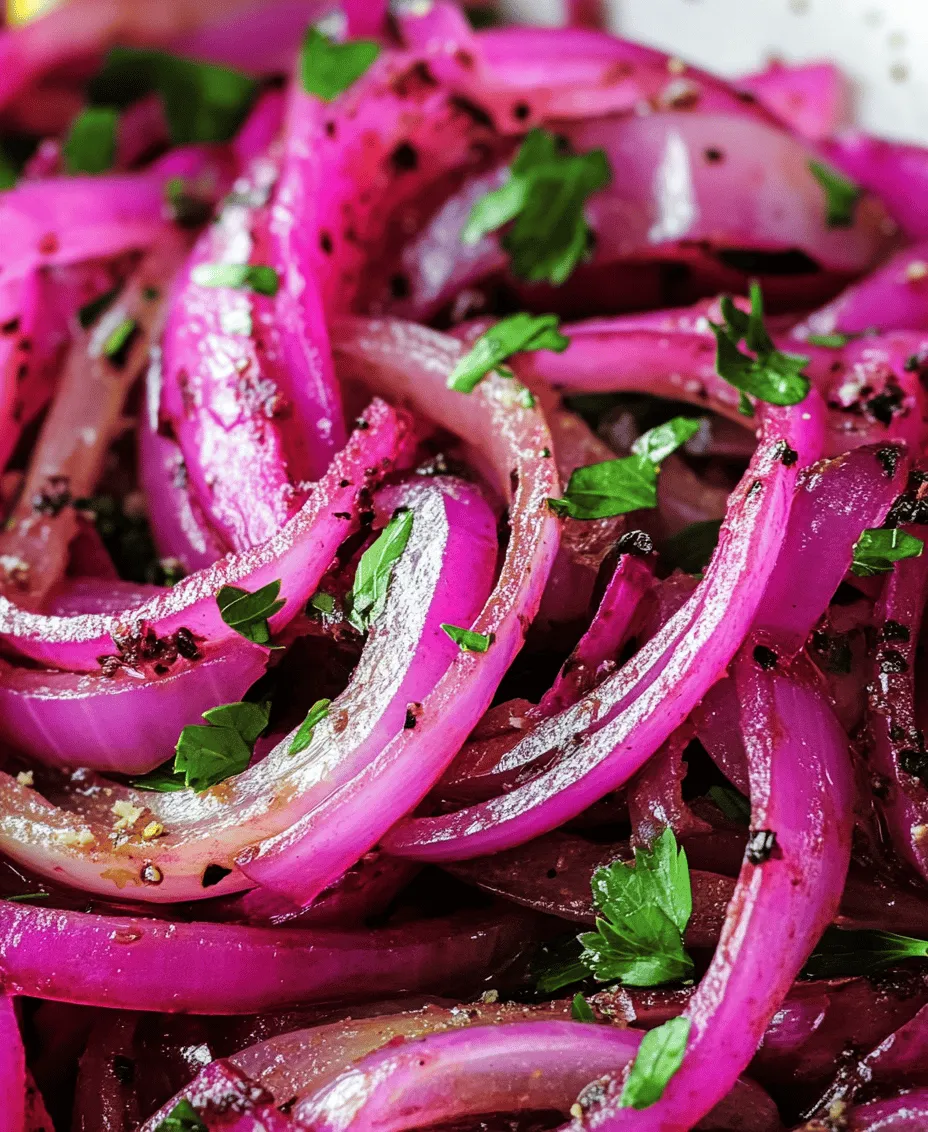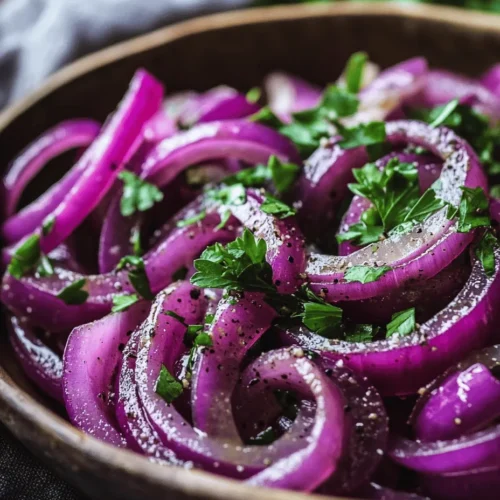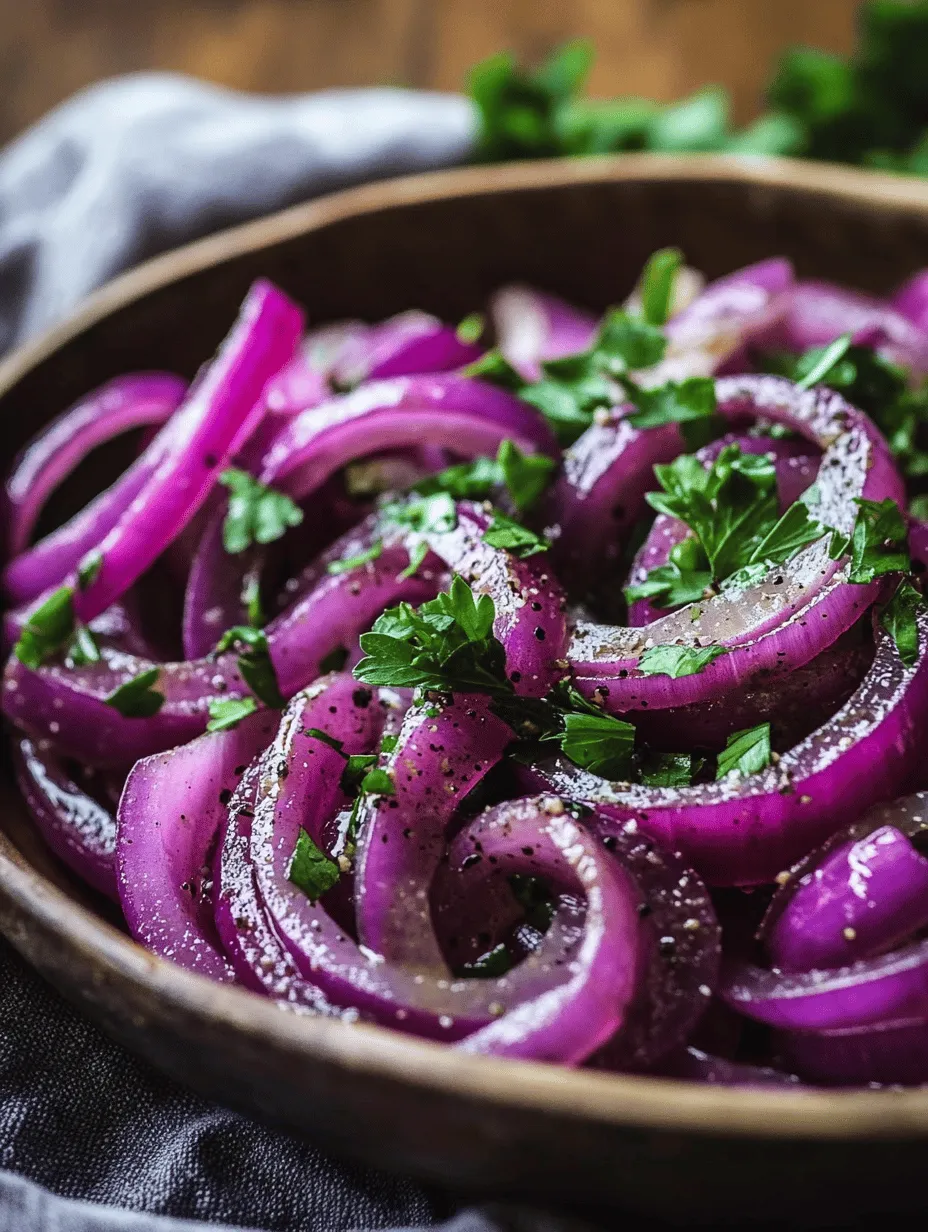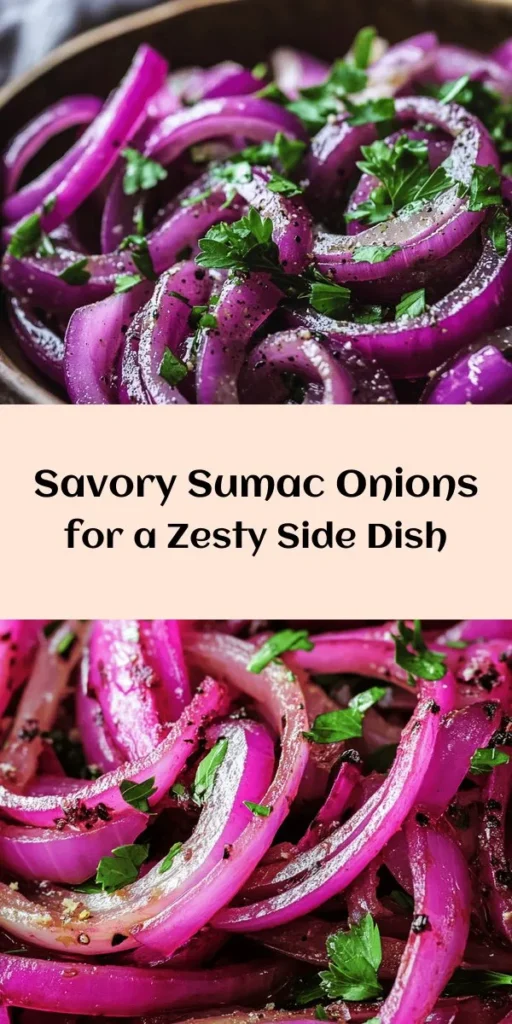Introduction
Understanding the significance of flavor in culinary creations is essential for any food enthusiast. One such delightful recipe that brings a burst of flavor and color to your table is the Sumac Onions Delight. This dish not only showcases the unique tanginess of sumac but also elevates the humble red onion into a star ingredient. Perfect as a tangy side dish, a topping for grilled meats, or even as a refreshing salad component, Sumac Onions Delight is versatile and easy to prepare. In this article, we’ll explore the origins of sumac, the nutritional benefits of onions, and provide a detailed guide on how to prepare this simple yet delicious dish.
The Allure of Sumac in Cuisine
Exploring the History and Cultural Significance of Sumac
Sumac, a spice derived from the dried and ground berries of the Rhus plant, has a rich history that spans across various cultures, particularly in the Middle East and Mediterranean regions. For centuries, it has been celebrated for its vibrant red hue and its ability to add a tart, lemony flavor to dishes. In ancient Rome, sumac was used not only for its flavor but also for its medicinal properties. As time progressed, this spice found its way into the kitchens of diverse ethnicities, becoming a staple in Middle Eastern cuisine, where it is often used to season meats and salads.
In many countries, sumac is more than just a spice; it symbolizes hospitality and generosity. It is commonly sprinkled over dishes like kebabs, tabbouleh, and even yogurt sauces, adding a refreshing kick that balances rich flavors. The culinary significance of sumac is profound, making it a beloved ingredient among chefs and home cooks alike.
Understanding the Flavor Profile of Sumac and Its Culinary Uses
The flavor profile of sumac is distinct and multifaceted. Its tartness is comparable to that of lemon juice, but it possesses a unique earthiness that sets it apart from other acids. This characteristic makes it an excellent seasoning that enhances the flavors of various dishes without overwhelming them. Whether used in marinades, dressings, or as a finishing touch, sumac brings a bright acidity that harmonizes beautifully with rich, savory ingredients.
Beyond its use in savory applications, sumac can also be found in sweet dishes, particularly in some regional desserts. Its versatility allows it to bridge the gap between different flavor profiles, making it an invaluable addition to any spice cabinet. Compared to other common spices like lemon zest or vinegar, sumac offers a more complex flavor that can elevate a dish in unexpected ways.
Comparing Sumac to Other Common Spices
While sumac has its own distinct flavor profile, it is often compared to other common spices such as lemon zest, tamarind, and vinegar. Each of these ingredients provides acidity, but sumac stands out for its fruity, tangy notes that can enhance various dishes. Unlike vinegar, which can sometimes overpower a dish, sumac offers a more subtle tang that complements rather than dominates.
This spice is also less acidic than lemon juice, making it ideal for those who may be sensitive to citrus. Many chefs recommend using sumac alongside these other ingredients to create a balanced flavor profile, as it can add depth and complexity to a dish without being overly sharp. As you explore the world of culinary flavors, understanding how sumac interacts with other spices will empower you to craft dishes that are both unique and satisfying.
The Versatile Red Onion
Nutritional Benefits of Red Onions
When it comes to versatile ingredients, red onions are a favorite among many cooks. Not only do they add a beautiful pop of color to dishes, but they also pack a nutritional punch. Red onions are rich in antioxidants, particularly quercetin, which is known for its anti-inflammatory properties. They also contain essential vitamins and minerals, including vitamin C, vitamin B6, and potassium.
In addition to their health benefits, red onions are low in calories, making them an excellent choice for those looking to add flavor without extra calories. Their unique flavor profile—sweet yet slightly pungent—allows them to be enjoyed both raw and cooked, making them a staple in salads, salsas, and various cooked dishes around the globe.
How Red Onions Differ From Other Varieties
While there are several varieties of onions, including yellow and white, red onions stand out due to their vibrant color and slightly milder flavor. The anthocyanins responsible for their deep purple skin also contribute to their unique taste and health benefits. Compared to yellow onions, which tend to be stronger and more pungent, red onions offer a sweeter and more delicate flavor, making them ideal for fresh preparations.
When cooked, red onions caramelize beautifully, developing a rich sweetness that can enhance a variety of dishes, from stir-fries to roasts. Their ability to hold their shape and color during cooking makes them an excellent choice for dishes that require a striking visual presentation and a balanced flavor profile.
Creative Uses for Red Onions Beyond This Recipe
Beyond the scope of Sumac Onions Delight, red onions have countless creative uses in the kitchen. They can be pickled for a tangy topping on sandwiches and tacos or sliced thinly to add crunch to salads. Roasting them brings out their natural sweetness, making them a delicious addition to grain bowls or pasta dishes.
Another popular preparation is grilling red onions, which enhances their sweetness and adds a smoky flavor that pairs well with meats. Additionally, they can be blended into dips or dressings, providing a flavorful base for various culinary creations. The adaptability of red onions makes them an essential ingredient in any home cook’s arsenal.
Ingredients Breakdown
Detailed Explanation of Each Ingredient Used in the Recipe
The beauty of Sumac Onions Delight lies in its simplicity and the quality of its ingredients. Here’s a closer look at what you’ll need to prepare this enticing dish:
1. Red Onions: The star of the dish, red onions provide both flavor and color. Their sweet yet slightly sharp taste complements the tang of sumac beautifully.
2. Sumac: This spice is what gives the dish its distinct tartness. Ensure you use high-quality sumac for the best flavor.
3. Olive Oil: A key component that helps to soften the onions while sautéing. Olive oil also adds richness and a subtle fruity flavor.
4. Fresh Parsley: Used as a garnish, fresh parsley adds a pop of color and freshness to the dish. It also contributes additional flavor that balances the richness of the olive oil.
5. Salt: Essential for enhancing the flavors of the other ingredients, salt helps to bring out the natural sweetness of the onions.
6. Pepper: Freshly cracked black pepper adds a hint of spice that complements the tanginess of the sumac.
Highlighting the Role of Olive Oil in Cooking
Olive oil is more than just a cooking fat; it is a vital ingredient that enhances the overall flavor and texture of dishes. Rich in monounsaturated fats, olive oil is known for its heart-healthy properties, making it a staple in Mediterranean cuisine. When used in the preparation of Sumac Onions Delight, olive oil not only helps to sauté the onions to perfection but also allows the flavors of the sumac and other ingredients to meld beautifully.
Choosing extra virgin olive oil is recommended for its robust flavor and higher antioxidant content. This oil is less processed and retains more of the natural flavor of the olives, which can enrich your dish. Whether you’re using it for sautéing, drizzling, or dressing, high-quality olive oil can elevate your culinary creations significantly.
The Importance of Fresh Parsley as a Garnish
Fresh parsley serves as more than just a garnish; it plays a crucial role in balancing the flavors in Sumac Onions Delight. Its bright, herbaceous notes cut through the richness of the olive oil and the sharpness of the onions, providing a refreshing contrast that enhances the overall eating experience.
In addition to its flavor contributions, parsley adds a vibrant green color to the dish, making it visually appealing. The freshness of the parsley also complements the tangy sumac, creating a harmonious blend of flavors that is both enticing and delicious. Always opt for fresh parsley over dried versions for the best flavor and nutritional benefits.
Step-by-Step Preparation of Sumac Onions Delight
Now that we have a solid understanding of the ingredients and their significance, let’s dive into the step-by-step preparation of Sumac Onions Delight. This straightforward recipe takes minimal time and effort, making it perfect for both novice cooks and seasoned chefs alike.
Step 1: Gather Your Ingredients
Before you start cooking, ensure that you have all the necessary ingredients on hand. This includes red onions, sumac, olive oil, fresh parsley, salt, and pepper. Having everything ready will streamline the cooking process and make it more enjoyable.
Step 2: Prepare the Onions
Begin by peeling the red onions and slicing them thinly. The thickness of the slices can affect the cooking time; thinner slices will cook faster and become softer. Aim for uniform slices to ensure even cooking.
Step 3: Heat the Olive Oil
In a large skillet, heat a generous drizzle of olive oil over medium heat. The oil should shimmer but not smoke. Once heated, add the sliced onions to the skillet, stirring to coat them evenly with the oil.
Step 4: Sauté the Onions
Cook the onions for about 10–15 minutes, stirring occasionally. You want them to soften and become translucent, allowing their natural sweetness to develop. If the onions start to stick to the pan, add a little more olive oil to keep them from burning.
Step 5: Add Sumac and Seasonings
Once the onions are soft and translucent, sprinkle the sumac over the sautéed onions, along with a pinch of salt and freshly cracked black pepper. Stir well to combine, allowing the sumac to coat the onions evenly. The heat will activate the sumac’s flavor, intensifying its tanginess.
Step 6: Finish and Garnish
After cooking for an additional 2-3 minutes, remove the skillet from heat. Transfer the Sumac Onions Delight to a serving dish and garnish with freshly chopped parsley. This not only adds a pop of color but also enhances the dish’s flavor profile.
With these steps, you now have a delicious Sumac Onions Delight that is ready to be served. This vibrant dish can be enjoyed warm or at room temperature, making it a versatile addition to any meal. Whether you serve it alongside grilled meats, as part of a mezze platter, or atop a fresh salad, this recipe is sure to impress your family and guests alike.

Preparing the Onions for Optimal Tenderness
To create the perfect Sumac Onions Delight, the first step is to prepare the onions properly. Choose medium-sized yellow or red onions for their balanced sweetness and flavor. Begin by peeling the onions and slicing them thinly, about 1/8-inch thick. Thin slices will allow the onions to cook evenly and caramelize beautifully, enhancing their natural sweetness.
Once sliced, soak the onions in cold water for about 10 minutes. This soaking process helps to mellow the sharpness of the onions, making them sweeter and more palatable when cooked. After soaking, drain the onions and pat them dry with a paper towel to remove excess moisture. This step is crucial as it ensures that the onions sauté rather than steam, leading to a more satisfying texture.
Heating the Skillet and the Importance of Proper Sautéing
Next, heat a large skillet over medium heat. Choosing the right skillet is essential; a heavy-bottomed pan or cast-iron skillet will distribute heat evenly and help achieve that perfect caramelization. Add a generous amount of olive oil, about 2-3 tablespoons, and allow it to heat until shimmering but not smoking.
Proper sautéing is the cornerstone of this dish. Once the oil is hot, add the prepared onions to the skillet in a single layer, ensuring they have enough space to cook without overcrowding. Overcrowding can cause the onions to steam rather than brown, preventing the delicious caramelization you desire.
Stir the onions occasionally with a wooden spatula, allowing them to pick up color without burning. The goal here is to soften the onions slowly and develop their natural sugars. This process can take anywhere from 15 to 20 minutes.
How to Achieve Caramelization and Its Impact on Flavor
Caramelization is a crucial step in creating depth and complexity in the flavor of your Sumac Onions Delight. As the onions cook, they will turn golden brown, and the sugars will begin to caramelize, resulting in a sweet, rich flavor. To enhance this process, you may choose to sprinkle a pinch of salt over the onions halfway through cooking. This helps to draw out moisture and aids in the caramelization process.
Once the onions reach a deep golden brown color, reduce the heat to low and continue cooking for an additional 5-10 minutes. This slower cooking phase allows for deeper flavors to develop while ensuring the onions remain tender and not burnt.
Incorporating Spices and Their Timing for Best Flavor Release
At this stage, it’s time to incorporate the star of the dish: sumac. Add about 1-2 teaspoons of sumac to the caramelized onions, stirring well to combine. Sumac, with its tangy, lemony flavor, will brighten the rich sweetness of the onions. The timing of adding the sumac is key; adding it too early can diminish its flavor, while adding it towards the end allows the spice to maintain its vibrant essence.
For an extra layer of flavor, consider adding additional spices like freshly cracked black pepper or a pinch of red pepper flakes if you enjoy a bit of heat. Stir these spices in and continue to sauté for another minute or two, allowing the spices to bloom and release their aromatic qualities.
Finishing Touches: Lemon Juice and Garnishing
Once the onions are perfectly caramelized and infused with the tangy sumac, it’s time for the finishing touches. Remove the skillet from the heat and squeeze the juice of half a lemon over the onions, stirring to combine. The acidity from the lemon juice will brighten the flavors and enhance the overall taste of the dish.
For garnishing, consider fresh herbs such as chopped parsley or mint, which will add freshness and a pop of color to your Sumac Onions Delight. A sprinkle of extra sumac on top can also provide an appealing visual element and an additional layer of flavor.
Serving Suggestions
Sumac Onions Delight is incredibly versatile and can enhance a variety of dishes. Here are some creative ideas for serving this delightful recipe:
1. As a Side Dish: Serve the Sumac Onions Delight alongside grilled meats, roasted vegetables, or as part of a mezze platter. The combination of sweet and tangy flavors complements many main courses beautifully.
2. Topping for Grilled Meats: This dish pairs exceptionally well with grilled chicken, lamb, or beef. The caramelized onions can be spooned over the meat, adding moisture and a burst of flavor that elevates the dish.
3. Incorporating into Salads: Toss the Sumac Onions Delight into your favorite salads for a zesty kick. They work wonderfully in grain salads, such as quinoa or bulgur, mixed with fresh vegetables and a light vinaigrette.
Nutritional Information
Sumac Onions Delight not only tantalizes your taste buds but is also packed with nutritional benefits. A serving of this dish (approximately 1/2 cup) contains around 120 calories, making it a light yet satisfying addition to your meal.
Onions are rich in antioxidants and vitamins, particularly vitamin C, which supports immune health and skin vitality. They’re also known for their anti-inflammatory properties. Sumac, on the other hand, is high in antioxidants and has been linked to various health benefits, including improved digestion and potential antibacterial effects.
This dish is suitable for various dietary preferences, including vegan, vegetarian, and gluten-free diets, making it a versatile choice for any gathering.
Conclusion
Sumac Onions Delight exemplifies the beauty of simple ingredients transformed into a flavorful dish. By harnessing the unique flavors of sumac and the natural sweetness of caramelized onions, this recipe offers a versatile addition to any meal. Whether served as a side, topping, or salad component, the Sumac Onions Delight is sure to impress and nourish, making it a worthy addition to your culinary repertoire.
Embracing the flavors and health benefits of this dish is an invitation to explore the vibrant world of cooking with spices and vegetables. The next time you seek a dish that is both delicious and visually appealing, remember the Sumac Onions Delight—an easy yet extraordinary way to elevate your dining experience.



